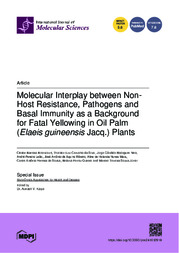Molecular interplay between non-host resistance, pathogens and basal immunity as a background for fatal yellowing in oil palm (Elaeis guineensis Jacq.) plants.
Molecular interplay between non-host resistance, pathogens and basal immunity as a background for fatal yellowing in oil palm (Elaeis guineensis Jacq.) plants.
Author(s): BITTENCOURT, C. B.; SILVA, T. L. C. da; RODRIGUES NETO, J. C.; LEAO, A. P.; RIBEIRO, J. A. de A.; MAIA, A. de H. N.; SOUSA, C. A. F. de; QUIRINO, B. F.; SOUZA JÚNIOR, M. T.
Summary: Abstract: An oil palm (Elaeis guineensis Jacq.) bud rod disorder of unknown etiology, named Fatal Yellowing (FY) disease, is regarded as one of the top constraints with respect to the growth of the palm oil industry in Brazil. FY etiology has been a challenge embraced by several research groups in plant pathology throughout the last 50 years in Brazil, with no success in completing Koch?s postulates. Most recently, the hypothesis of having an abiotic stressor as the initial cause of FY has gained ground, and oxygen deficiency (hypoxia) damaging the root system has become a candidate for stress. Here, a comprehensive, large-scale, single- and multi-omics integration analysis of the metabolome and transcriptome profiles on the leaves of oil palm plants contrasting in terms of FY symptomatology?asymptomatic and symptomatic?and collected in two distinct seasons?dry and rainy?is reported. The changes observed in the physicochemical attributes of the soil and the chemical attributes and metabolome profiles of the leaves did not allow the discrimination of plants which were asymptomatic or symptomatic for this disease, not even in the rainy season, when the soil became waterlogged. However, the multi-omics integration analysis of enzymes and metabolites differentially expressed in asymptomatic and/or symptomatic plants in the rainy season compared to the dry season allowed the identification of the metabolic pathways most affected by the changes in the environment, opening an opportunity for additional characterization of the role of hypoxia in FY symptom intensification. Finally, the initial analysis of a set of 56 proteins/genes differentially expressed in symptomatic plants compared to the asymptomatic ones, independent of the season, has presented pieces of evidence suggesting that breaks in the non-host resistance to non-adapted pathogens and the basal immunity to adapted pathogens, caused by the anaerobic conditions experienced by the plants, might be linked to the onset of this disease. This set of genes might offer the opportunity to develop biomarkers for selecting oil palm plants resistant to this disease and to help pave the way to employing strategies to keep the safety barriers raised and strong.
Publication year: 2023
Types of publication: Journal article
Unit: Embrapa Agroenergy
Observation
Some of Embrapa's publications are published as ePub files. To read them, use or download one of the following free software options to your computer or mobile device. Android: Google Play Books; IOS: iBooks; Windows and Linux: Calibre.
Access other publications
Access the Agricultural Research Database (BDPA) to consult Embrapa's full library collection and records.
Visit Embrapa Bookstore to purchase books and other publications sold by Embrapa.

